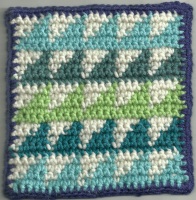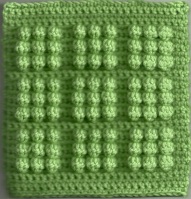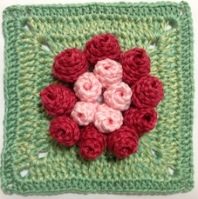I thought it might be good to explain how the process of producing a pattern book goes: it might not be quite what you imagine! Although I’ve worked on two different ones now, there were many elements in both that were much the same, but I will talk about A Square a Day first, then tell you how making Knitting Basics went in a later post.
The first thing that was decided was the concept of the book. In the case of both my first two books, this had already been developed by the respective publishers, and I was recruited to produce the book. The titles were pre-chosen, as were the covers. I was contacted by the publishers after a recommendation from a colleague (thank you Catherine!) and I then met with them and agreed the details. We then went back and forth a little until we were happy with the format. I was warned that it was a”big book” and “a challenge” but I decided that you don’t get offered an opportunity like this every day, and anyway, writing a book had long been on my bucket list. So I accepted the offer. Formal contracts were drawn up then it’s off you go! {L-R below: by me, Lucy Adam, Katie Clammer]
The UK publishers were Ivy Press, based in Lewes, Sussex, in a little dog-frendly office that I loved visiting. They’d already sold the rights to Interweave Press in the USA by the time I was brought on board; the book was to be produced in US terminology and it would be translated into UK terms once it was finished.
The book then got thrashed out in more detail: I couldn’t make all 365 designs myself in the time available so I had to find some co-contributors. I had already known Lindsay Obermeyer and Pauline Richards for many years, so I got them on board, and the publishers suggested 3 more people, Lucy Adam, Katie Clammer and Deborah Smethurst, all of whom have now become good friends! Finally, I found a younger member of our team when I attended the New Designers show in London: Lindey Tydeman’s work has a fresh aesthetic to it that I really wanted to include. I spent a long time trying to come up with some sort of formula for making sure there was a good spread of projects in each chapter: I had to consider levels of ability as well as type of stitch/pattern. In the end, I made a cloud spreadsheet that all the contributors would be able to access with a password, so that we could all see what was assigned to us, and who was making what (and thankfully, we only had a couple of instances of people duplicating patterns, so not much wasted effort.)
Over the following months we spent hours Skypeing, calling and meeting up to share ideas, support each other and check our work. I checked all the other contributors’ patterns by making up the squares and annotating anything I found wrong. My own were to be checked by Interweave. All the text was then gone through by our fantastic copy editor, Marie Clayton. She misses nothing! We submitted our squares in batches, and made sure we all got to see them all laid out, as they looked so lovely all together in their rainbow palette. The photos above are of our first batch being submitted back in December 2013. We noticed around this time that the book was listed on Amazon already, even though we were still making it! That was amazing to see, and also to see that people were pre-ordering it from a really early stage. Because page sizes are so tight, and it was already a pre-formatted book, our instructions sometimes got abbreviated by the editing team, but as I know I can be a bit wordy, I was happy to bow to their experience in these matters and trust that all would still be clear to the reader. [below: 3 squares by me]
Once the first batch were in the design team at Ivy Press got the squares photographed then started making layouts of the pages, and sending them to me to check. There were a few squares back to front or upside down, but this was quickly rectified. Once we were happy then this batch of pages went off to Interweave Press in Colorado, our US publishers, to check and comment on. Luckily they had very few things for me to amend. I then started work on the instructional pages at the front whilst simultaneously working on the second batch of squares. That was a crazy busy time! LOTS of very late nights, some all-nighters, lots of hand cramps and arnica gel, but strangely, a never-ending supply of fresh ideas that just kept coming! I’d notice things when I was out walking my dog, like the pyracantha berries in our local park, and then I’d come home and create a design from it, it was very stimulating and exciting. [below: 3 squares by Deborah Smethurst]
The instructional pages took some time to put together as I had to source lots of illustrations fresh for this book. I wanted to apply the teacher’s rule of “assume nothing” so decided I’d rather over-explain than leave people wondering. Once we had everything ready for that section, Marie checked the text and the drawings were made, then I checked it all again before it went off to Interweave for their approval. Meanwhile, the final batch of squares was being put together by my team, and I was checking their patterns. It got harder as we approached the end, because we often found we had ideas that didn’t fit into the skill level that was needed for the last few squares, or we already had too many of that particular technique. We actually talked about doing a volume 2, can you believe?!
Towards the final stages of the book I had to pull out for a while, because sadly, my mum died and I was very caught up in dealing with her affairs, as well as grief. So my last squares were checked by Deborah, and also the last bits of text. The UK translation happened at that stage, but I never saw the UK version of the book until it actually came out, because I was so out of the loop at that time.
[below L-R: by Pauline Richards, Lindey Tydeman, Lindsay Obermeyer]
Once everything went in, all went quiet for a while, as the books were being physically made at the printers. I sent in some marketing info, with ideas as to who to send review copies to, then before we knew it publishing day had arrived! I didn’t have my author copies yet but I sent for one on Amazon as I was so impatient to see it. I also went to Foyles bookshop in central London and there was my book, proudly on the shelves with all the other crochet books! It was very surreal to see, after all that work, so gratifying! In early December I got my author copies and extracts from the book, and reviews, started appearing in magazines. #crochet magazine featured 4 of our squares and called them “cool”, which was very flattering!
I then received a copy of the US version and started to see reviews cropping up all over the Internet, and I was also able to see the Amazon sales figures every day. I think the really high point came when Moogly ran a competition to win ONE copy and they had almost 50,000 entries. That was pretty mind-blowing! [below L-R: by Deborah Smethurst, me, Katie Clammer]
Now that the book has been out a little while, I’ve calmed down about reading the reviews every single day. Inevitably, a few errors seem to have slipped through our checking net, so I will find a way to post errata both in the UK and the US. People have been really positive and lovely about the book, which is just great. It’s very exposing, putting yourself out there for public consumption and appraisal. I try to learn from any suggestion or criticism, though. Each one will help me make my next book better!

















